Tillandsia streptocarpa
Click thumbnails for full size, scaled to a new window.
Tillandsia streptocarpa
Note: aff. streptocarpa "White(Weiss) foliage" form and "Green(Grun) foliage" form were moved to T. Chicitos, but are now called T. santiagoensis
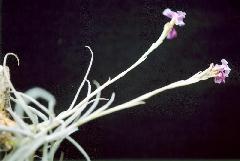
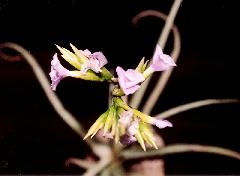
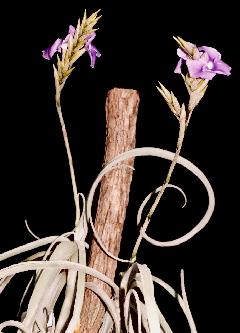
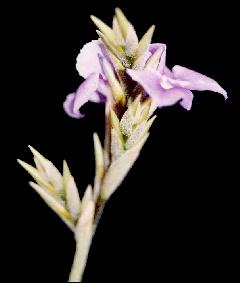
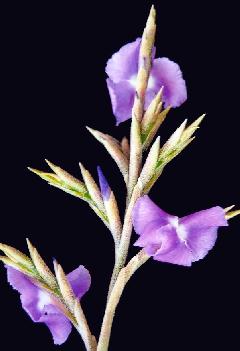
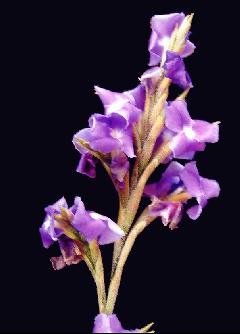
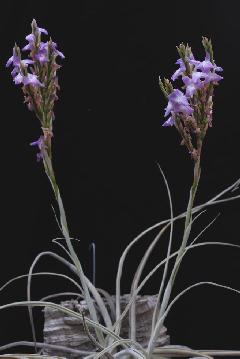
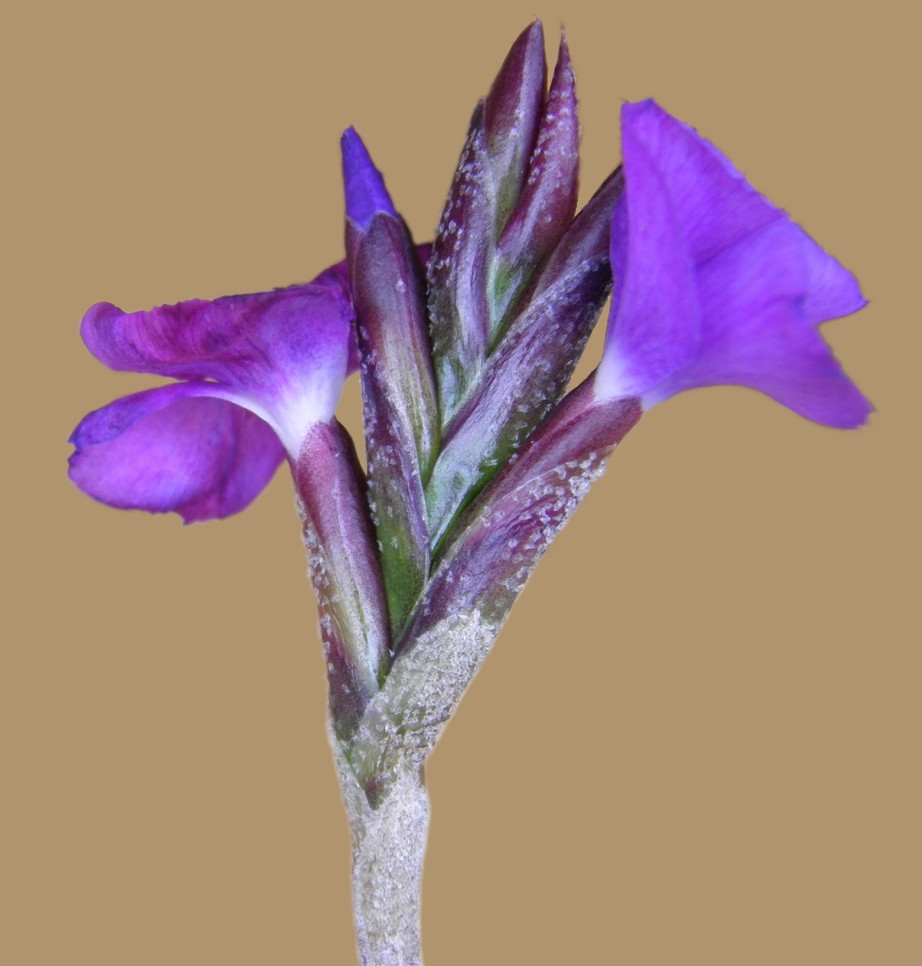
| Ken Woods 11/06 |
George Nieuwenhoven 02/08. |
Derek Butcher 01/17 -seed from Knize 1991 ! |
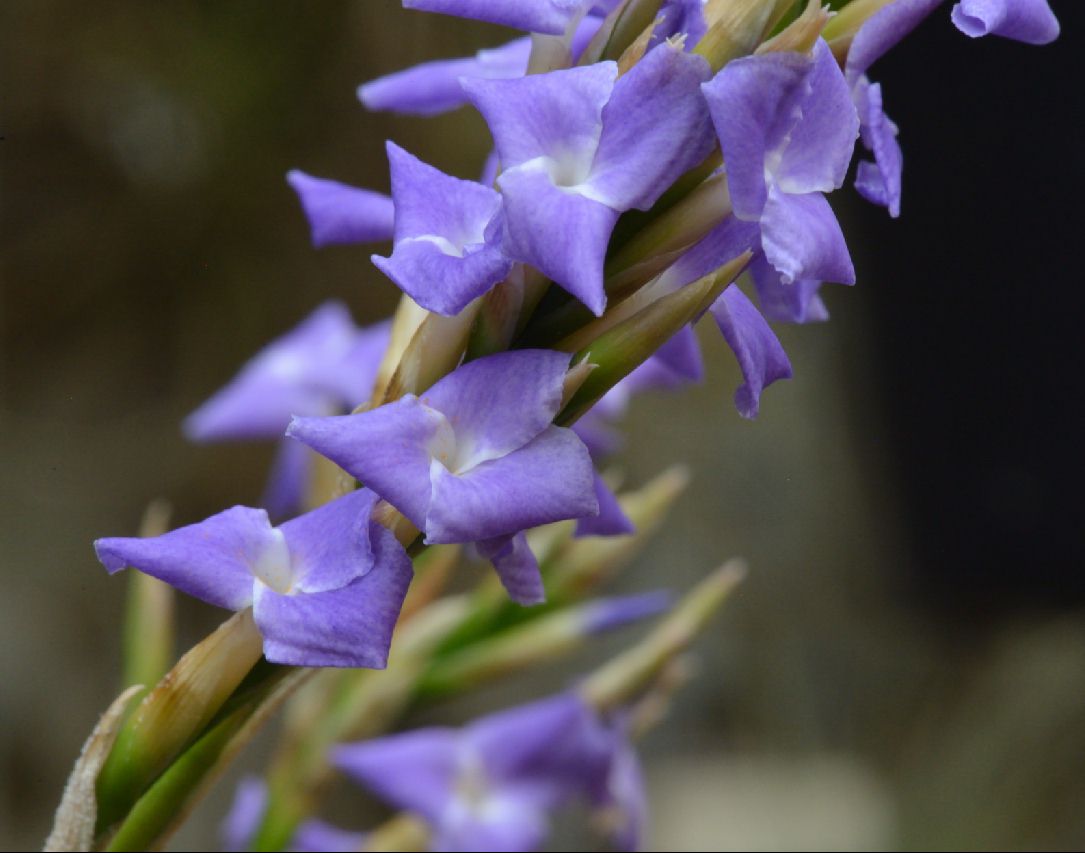
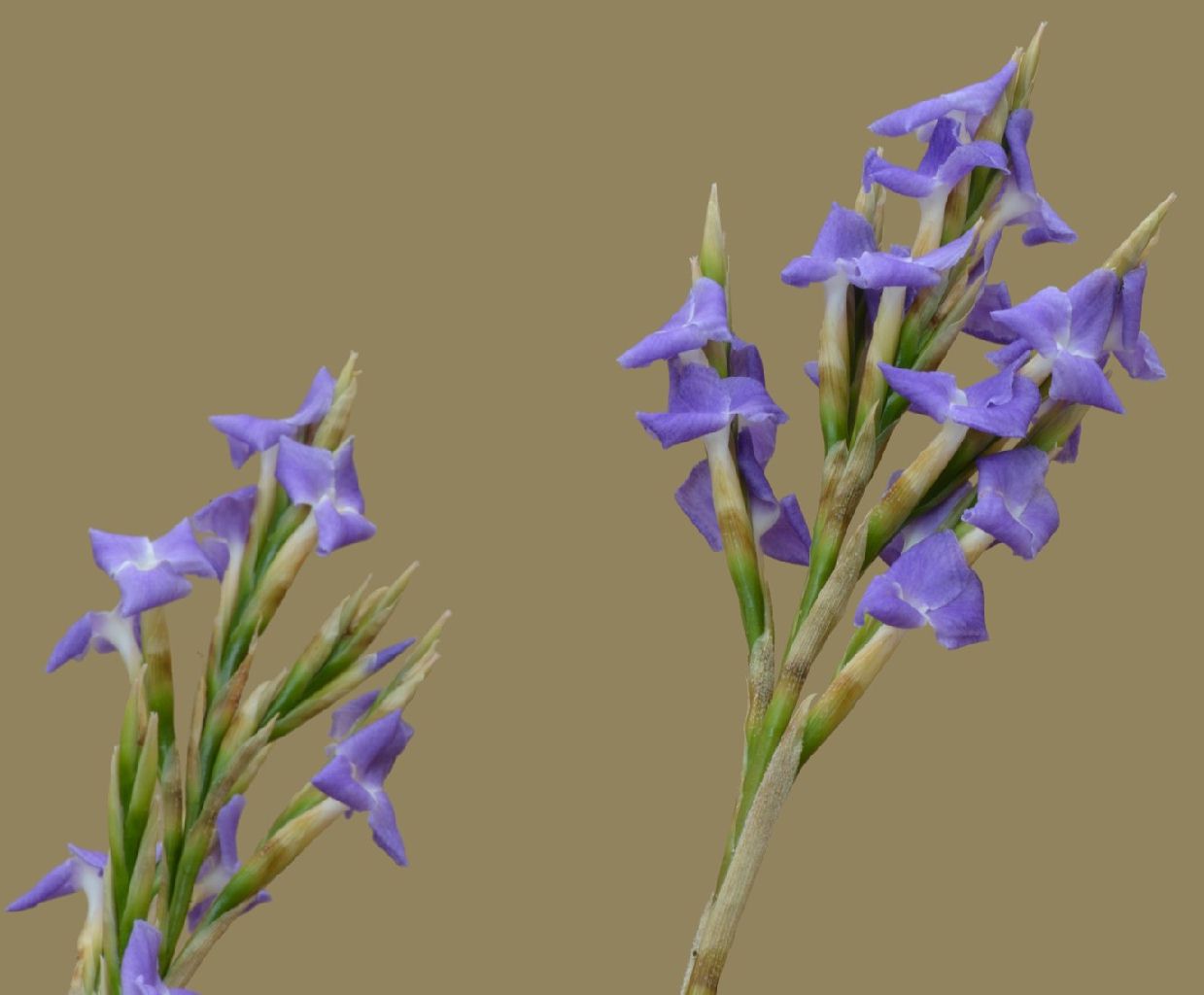
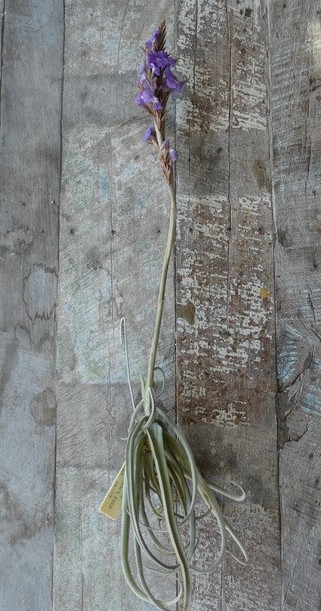
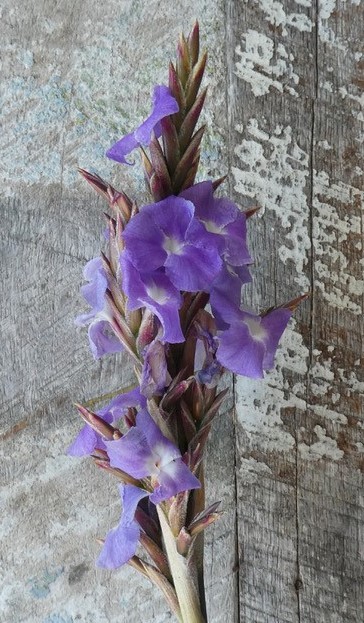
| George Nieuwenhoven 01/19 |
Bruce Dunstan 08/21 |
George Nieuwenhoven ... "This must be one of the easiest Tillandsias to grow. Beautiful flowers and heavenly scent, comes in white as well."
Peter Tristram ... "You cannot have too many of these! How do you tell it from reichenbachii? Just one to ponder! Send it to me and I’ll cross it with erici - all of mine have finished blooming!"
George Nieuwenhoven ... "My reichenbachii appears smaller in stature and flowers are more open on it, apart from that they could easily be the same species. For now I will keep the original name on them. Oh, and not to forget they bloom at the same time so what you are alluding to is probably correct."
Bruce Dunstan ... "This is by far the largest T. streptocarpa I grow. It originated with Wally Berg and was brought back from Tropiflora by Greg Aizelwood."
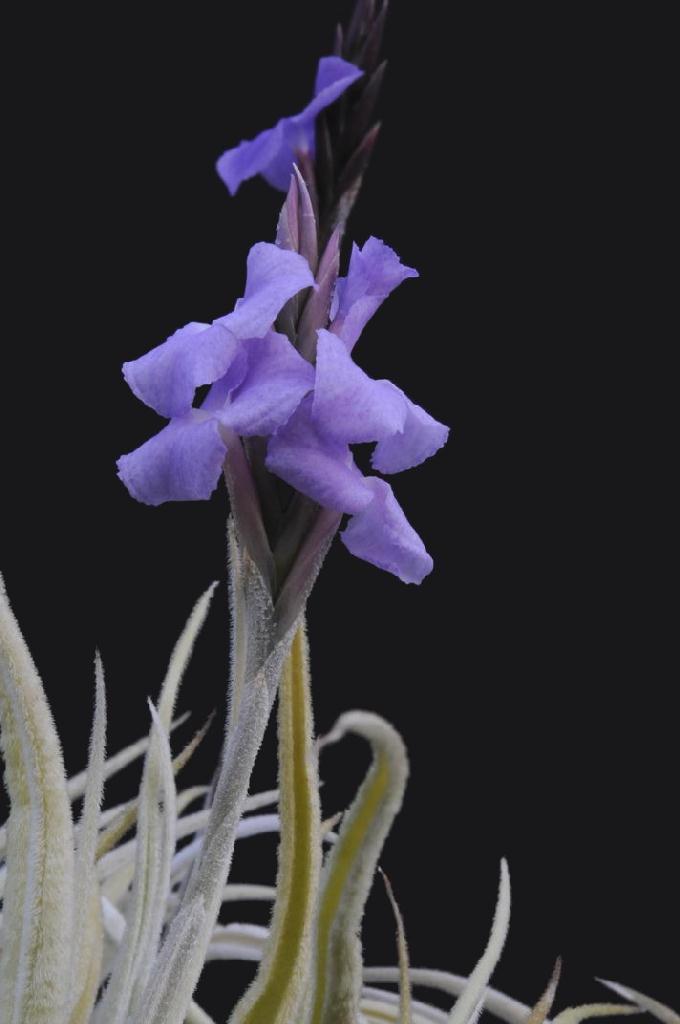
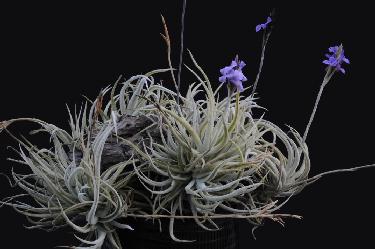
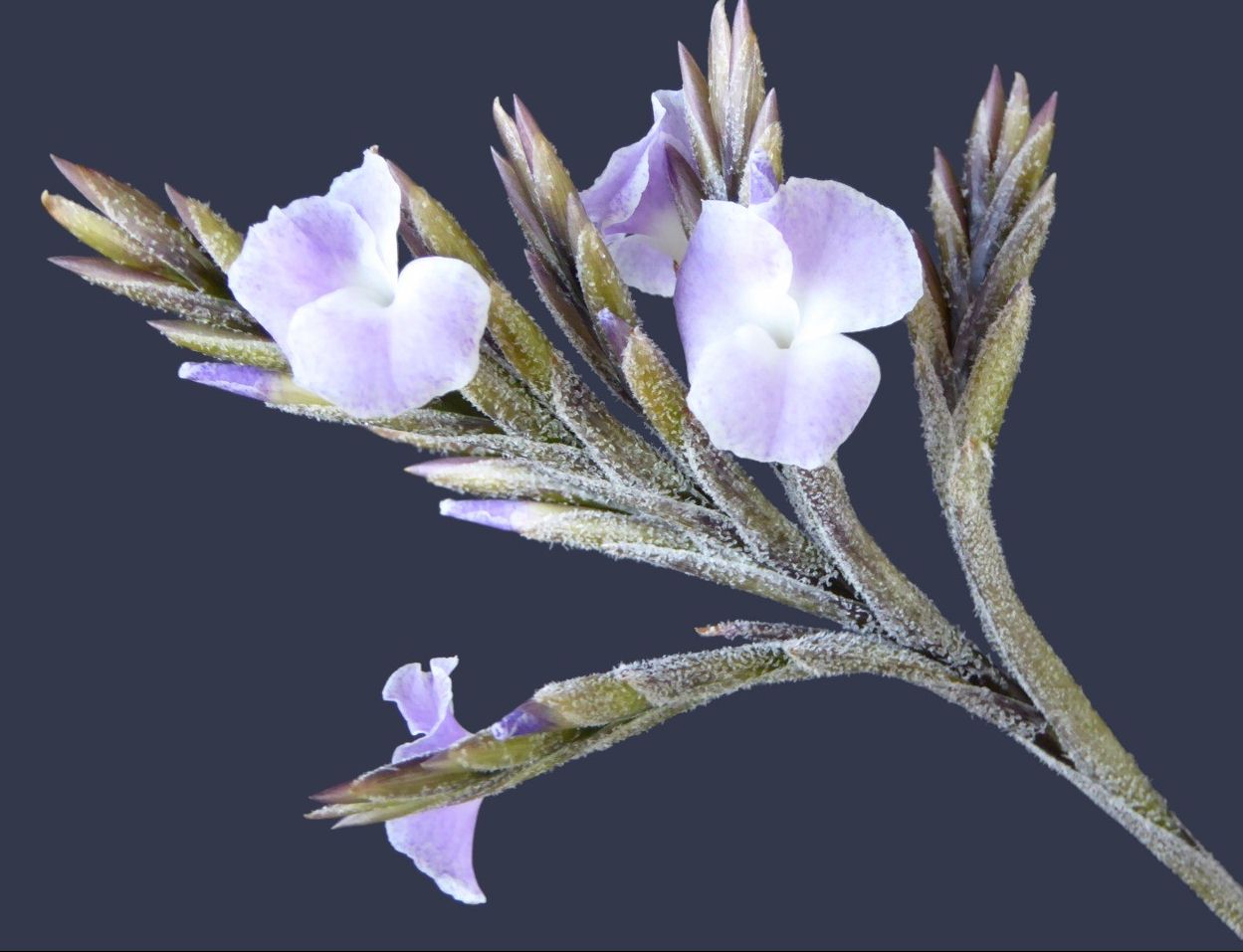
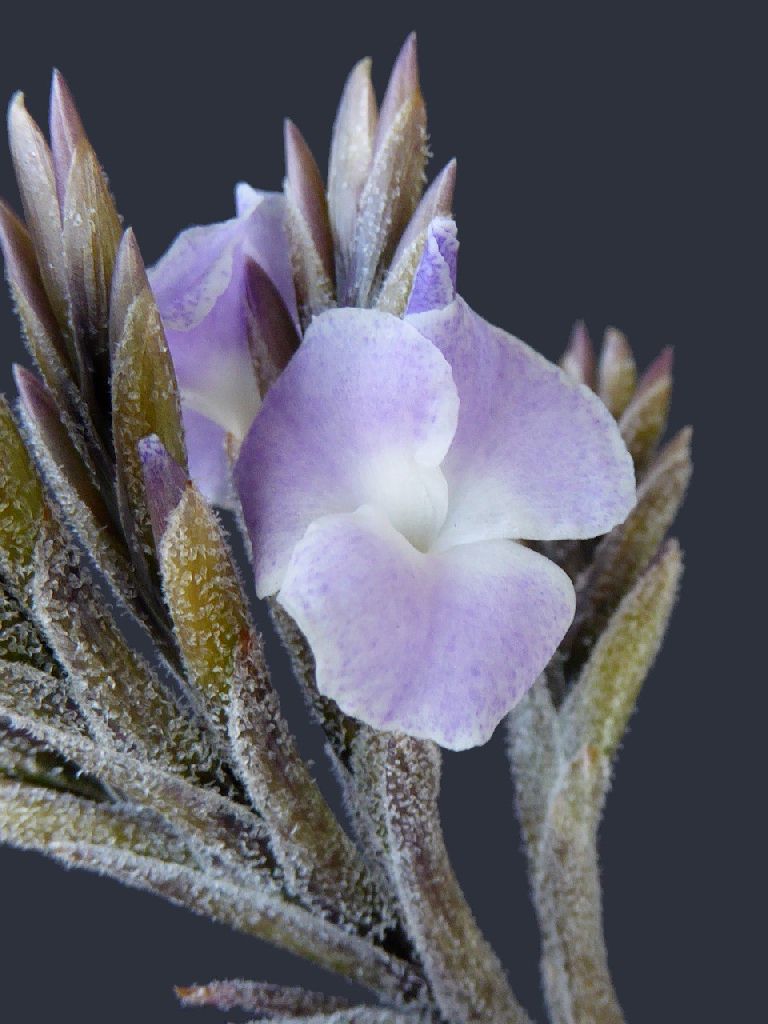
Peter Tristram 12/10. (Weiss)
N.B. 01/12. This form is listed as 'Succulent Silver' pending registration or further detail.
07/20. Now called T. santiagoensis |
Bruce Dunstan 10/17 ex. Peter Tristram |
Bruce Dunstan ... "First flowering of this plant for me. It is a few weeks ahead of the white streptocarpa that Bob Hudson has already flowered in Sunny Cairns. This has the beautiful scent and shares both parents in the resulting flowers."
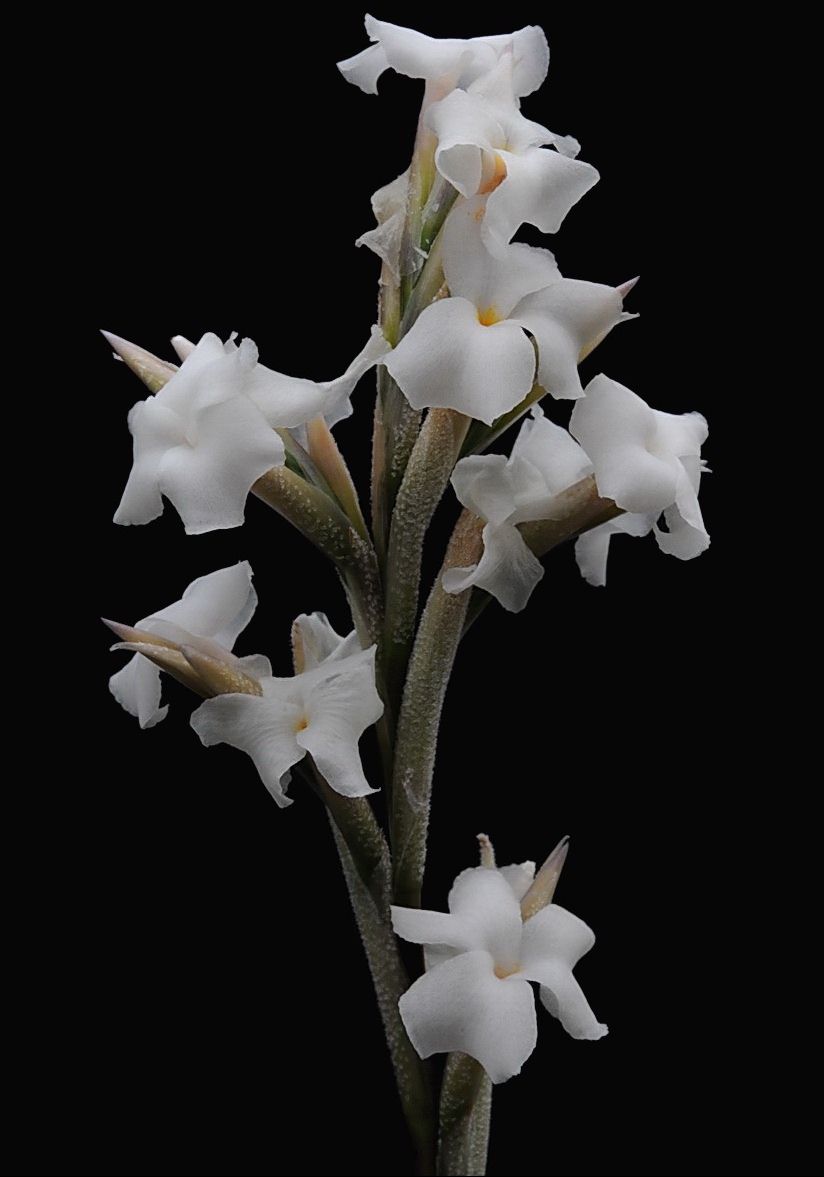
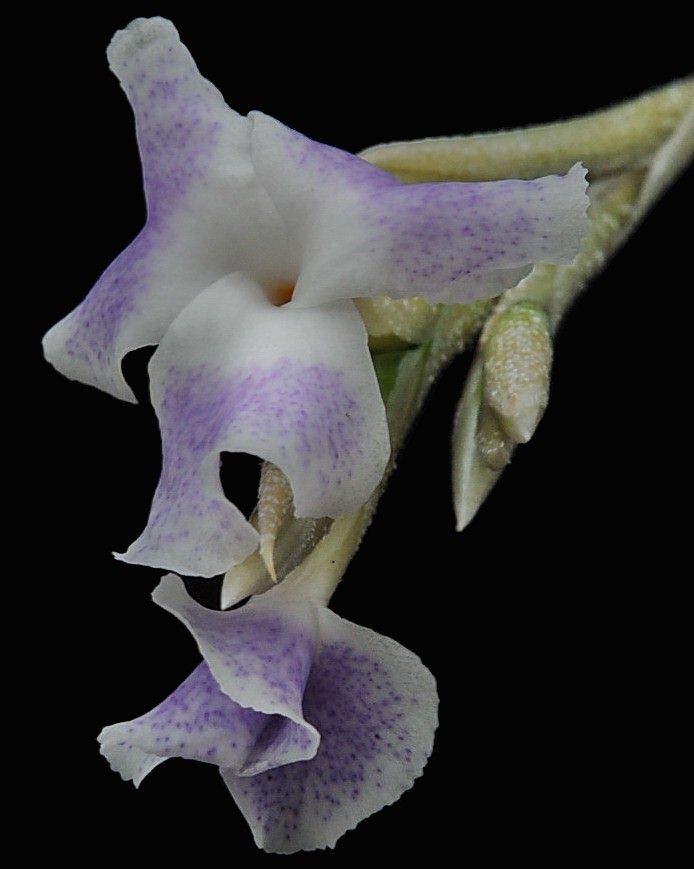
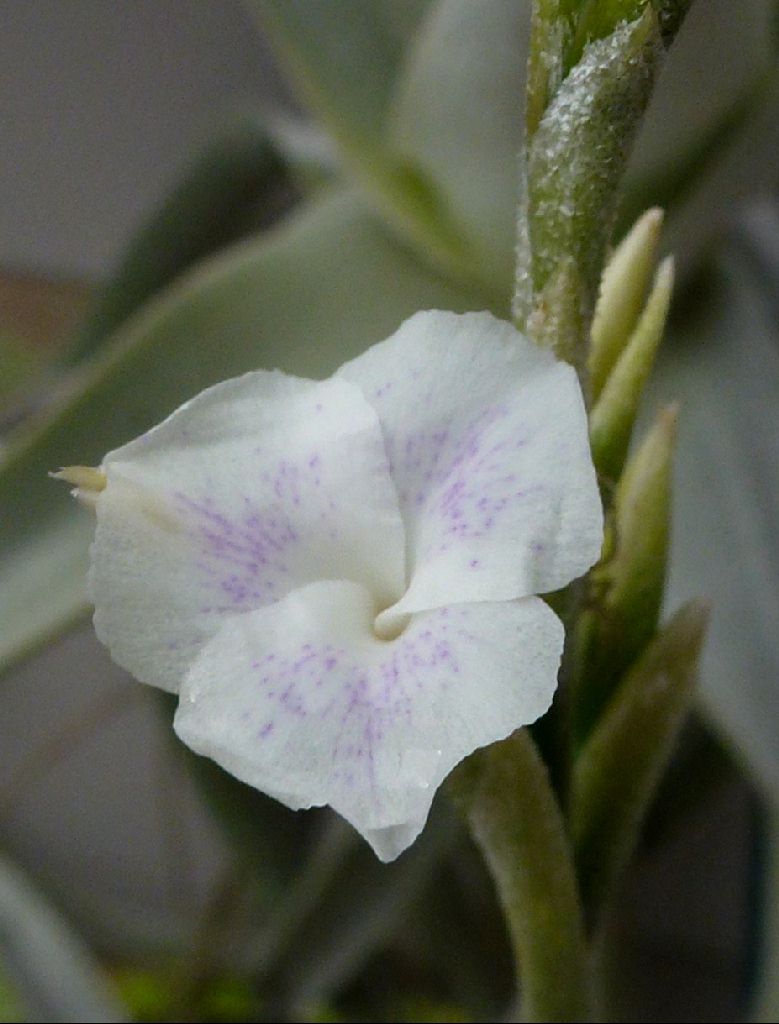
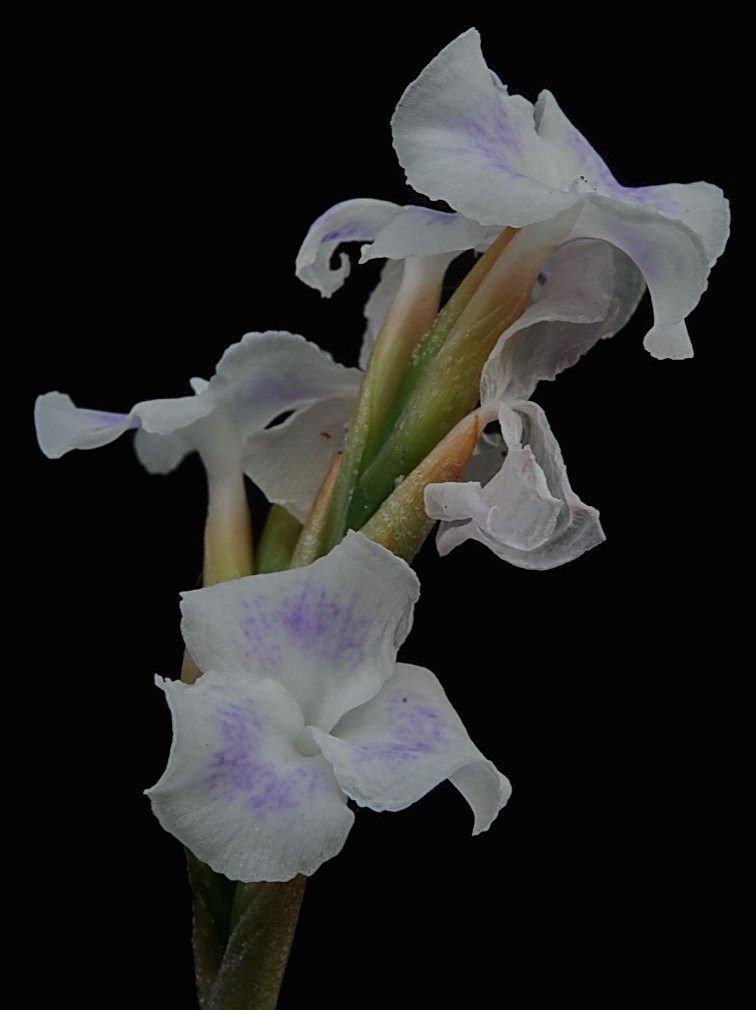
| Peter Tristram 12/11 streptocarpa White from Lotte Hromadnik. |
Peter Tristram 12/11 streptocarpa White from Burkhard Holm. |
Bruce Dunstan 12/11 as streptocarpa White. |
Peter Tristram 12/11 as reichenbachii White from Barry Genn. |
Refer also to T. reichenbachii. See discussion below (not yet complete?) from Tillandsia discussion group...
Peter Tristram 19/12/11 - I decided to take some pics of a plant Barry Genn recently (very) gave me. It is referred to as T. reichenbachii White (flowered form) and a lovely little beauty at that. As you can see there is some pigment in those petals. What struck me was the close resemblance to a plant from Burkhard Holm - plant obtained as seedling from T. streptocarpa White and probably a cross of White with the normal form. Once again, interesting pigmentation on close examination. A macro of the white streptocarpa from Lotte is also attached and this one is all white with a yellow corolla – there is variation in this group of Lotte’s collected plants.
Apart from how lovely these forms are, the name reichenbachii again confuses me. All of the plants I have seen and imported as either reichenbachii or tucumanensis (synonyms) are very small, only about 10-15cm in bloom whereas the descriptions refer to plants of 20cm or more with a dense rosette of polystichous leaves. Uwe Scharf has spent considerable time studying the complex including streptocarpa, arhiza, retrorsa, paleacea, duratii, graomogolensis and so on, both in the extensive European collections and in the wild. He makes interesting listening on this group, so I am going to ask if he has a summary he can help us with.
Chris Larson 20/12/11 - What I saw in the valley immediately to the north of Tucuman & most other places around NW Argentina was this smaller “reichenbachii” – the one we generally call reichenbachii here. Remember that Marj collected either 2 or 3 times in this area before she went there with me. I remember one locality in particular, probably somewhere near Salta or Jujuy, there was a location where there were heaps of what we call reichenbachii - and there were different coloured flowers at the same locality in dry scrubby forest, including the white one. Both Marj & I bought back a fair bit of the white one.
There is a form of “reichenbachii” that, I think, Cliff Norden used to sell at the BSA shows, which was quite a bit larger than the ones Marj & I collected, more like the 20cm plants of which you speak. Many nutters must have the descendants of Cliff’s seedlings – as well as Marj’s.
The strepto white from Holm can also be blue. I think that he may have been referring to foliage! It is certainly a chunky little white plant.
Bruce Dunstan 24/12/11 - My White streptocarpa flowered and it's white and purple as well.
Peter Tristram 24/12/11 - Hi Bruce. Was it from me? I have whites from 2 sources and only a couple of the Hromadnik ones are pure white, albeit with a yellow corolla.


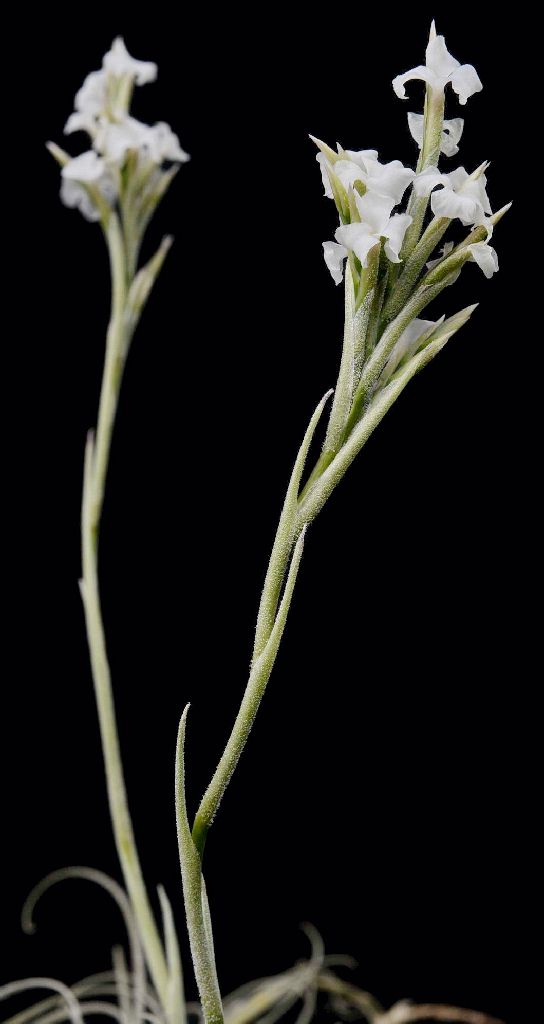
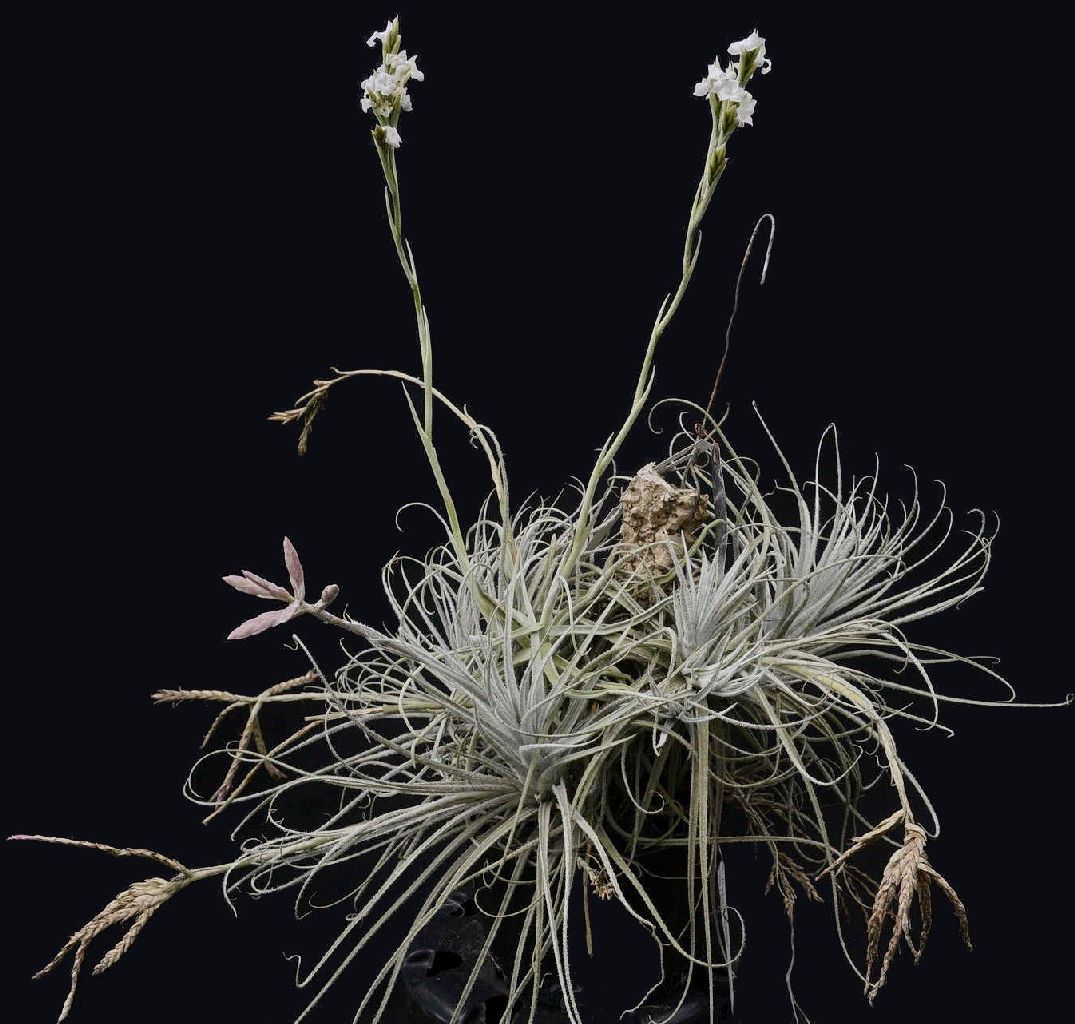
| Bruce Dunstan 10/17 ex. Peter Tristram |
Peter Tristram 12/18 Lotte's white seedling on a tectorum |
Bruce Dunstan ... "First flowering of this plant for me. It is a few weeks ahead of the white streptocarpa that Bob Hudson has already flowered in Sunny Cairns. This has the beautiful scent and shares both parents in the resulting flowers."
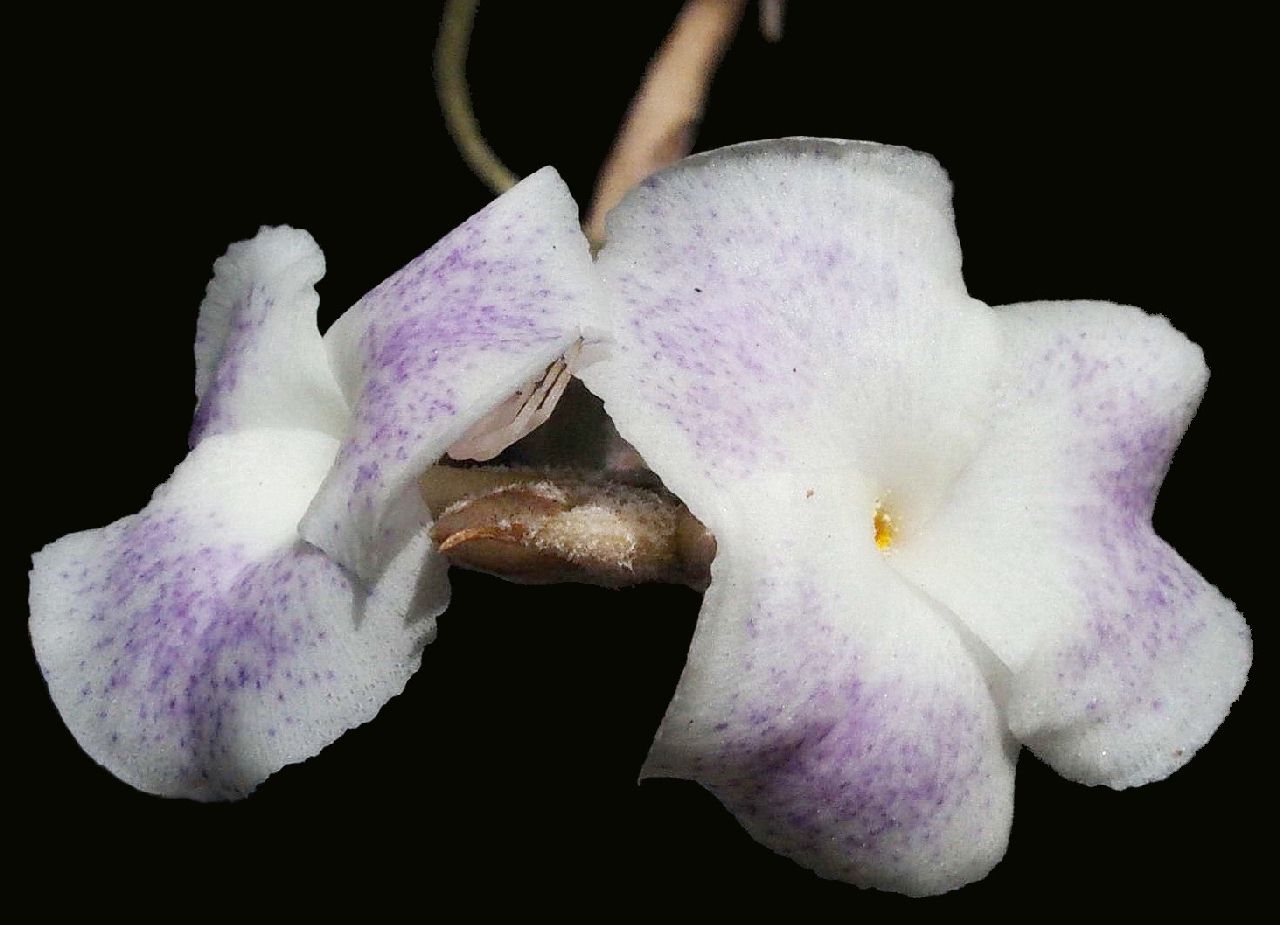
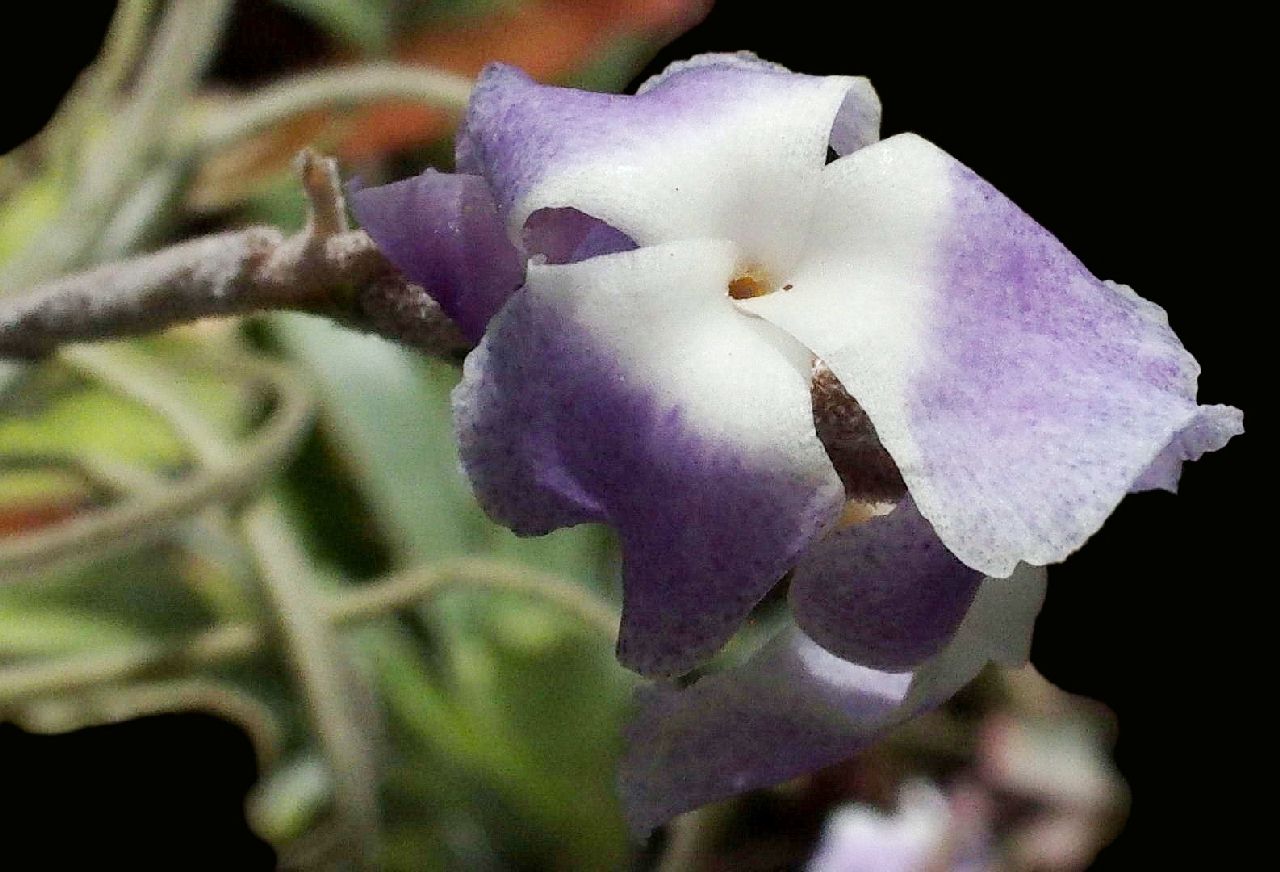
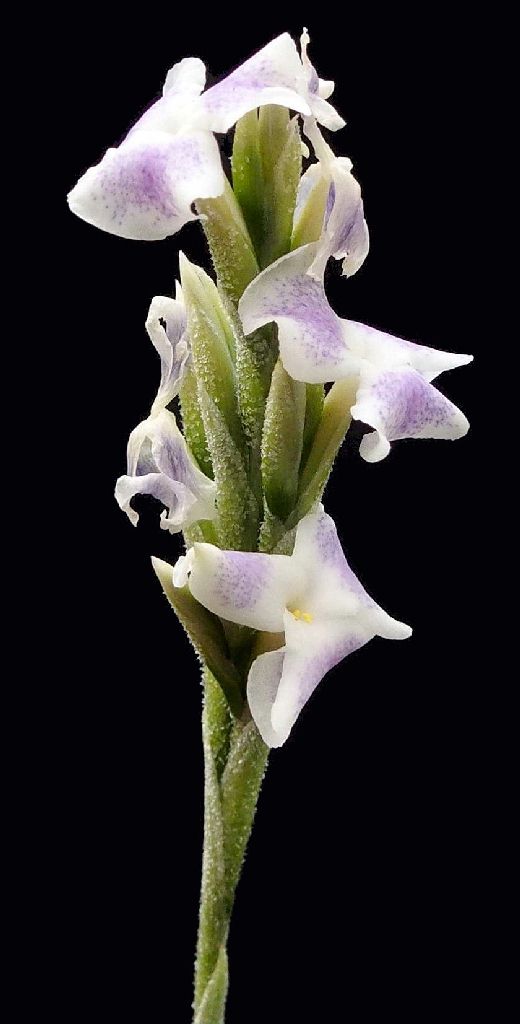
| Peter Tristram 12/18 white x blue PT, 2 types |
Peter Tristram 12/18 white x blue Holm |
Peter Tristram ... "At the moment it’s streptocarpa (and its relatives) blooming season. We see the various ‘normal’ blue flowered forms and the odd white ones being shown off and discussed here and there. A few years back I crossed some blue ones with a pure white form from Lotte, both ways, with bloomings over the last few years. Some collectors have bought them at various shows and Till days, under formula.
Holm also did a similar cross and Chris and I have bloomed them for a few years now.
The resulting plants have mostly spotted petals though some are blue with a large white throat. I took a few pics of 3 different crosses – see attached pics, with a lot more to burst flowers in the next couple of weeks. Over the next few years quite a few different versions will begin to bloom. Do I grex name them or give each seedling a name? No two are exactly the same! To date I have sold them under formula.
A streptocarpa seedling, which hitched a ride on one of Lotte’s tectorum, has bloomed pure white too. Pics also attached. This year I have been busily pollinating white forms from 3 different sources (and some others!)."
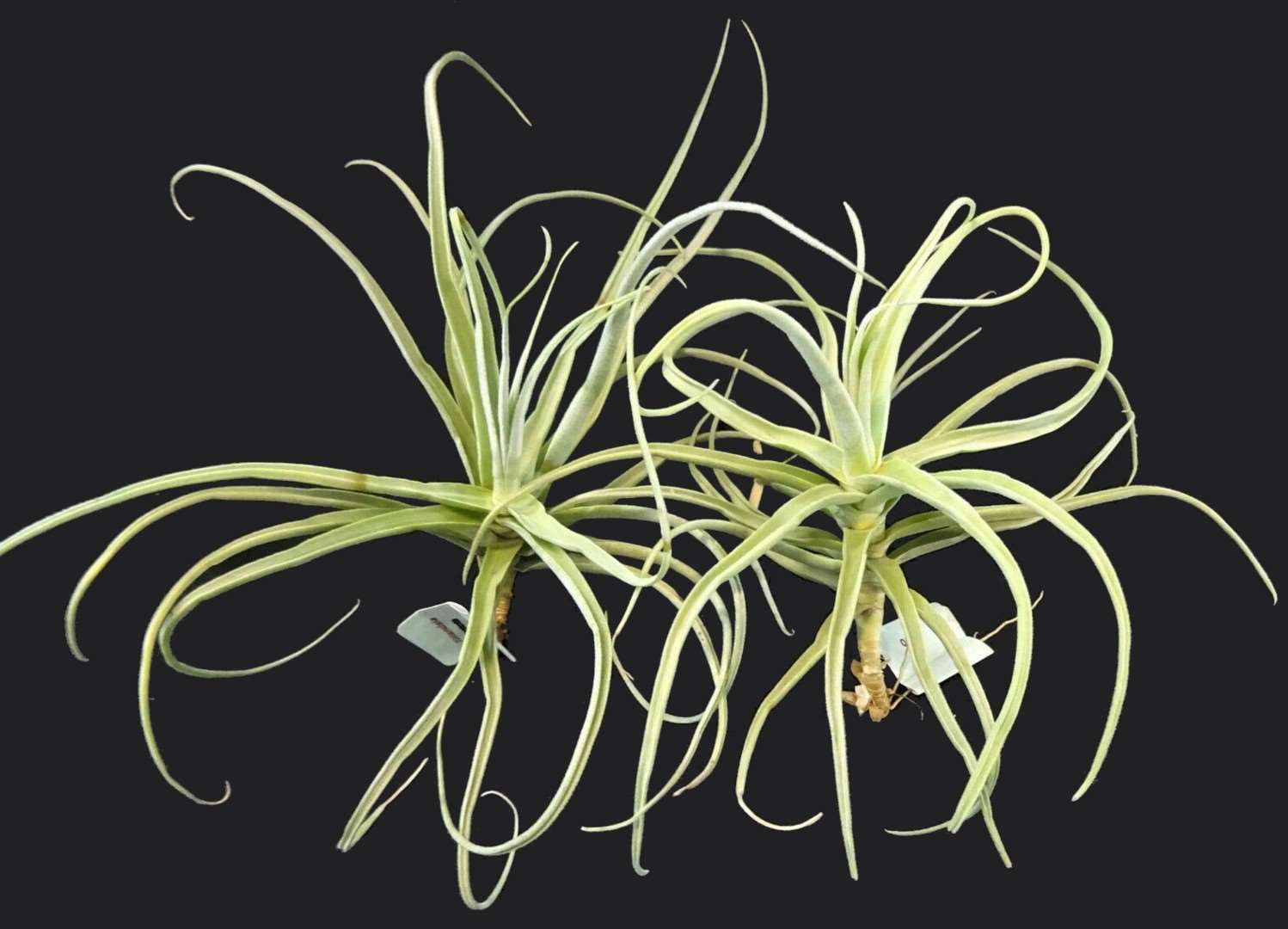 Chris Larson ... "Collectors Corner have been selling this plant as T. streptocarpa for quite a while now. Previous flowerings have been a bit weedy, the results of gassing – so my mind went to depauperate flowering. Finally I got photos of this one that I think is true to its potential.
Chris Larson ... "Collectors Corner have been selling this plant as T. streptocarpa for quite a while now. Previous flowerings have been a bit weedy, the results of gassing – so my mind went to depauperate flowering. Finally I got photos of this one that I think is true to its potential.
Many of you know that I have no faith in Mr Occam as his science was from the 14th century - & I think it should stay there. Maybe that’s just an excuse for me always ending up in the wrong spot with dichotomous choices in the keys. The simple answer often doesn't get us to the right place.
…. Anyway, to cut to the point …. If this weren’t T. streptocarpa, which of its allies would be most likely? So I can check them out."
Tillandsia streptocarpa Baker, Jour. Bot. London 25: 241.1887.
Tillandsia tricholepis Baker, Jour. Bot. London 25: 234.1887; non Baker 1878. Type. Vicinity of Rio de Janeiro, Brazil, Glaziou 13243 (C, K, K photo 7443).
Tillandsia soratensis Baker, Jour. Bot. London 25: 235. 1887. Type. Sorata, La Paz, Bolivia, Mandon 1185 (K).
Tillandsia bakeriana Britten, Jour. Bot. London 26: 170, 172. 1888; nomen novum for Tillandsia tricholepis Baker, 1887, non 1878.
Tillandsia condensata Baker, Handb. Bromel. 164. 1889. Type. Azero, Chuquisaca, Bolivia. Wed¬dell s n (P).
Tillandsia streptocarpa var peruviana Ule, Verh. Bot. Brandenb. 48: 146. 1907. Type. Salinas de Pilluana, Rio Huallaga, San Martin, Peru, Ule 6663 (CORD, C, K, L), Jan 1903.
Tillandsia apoloensis Rusby, Bull. N. Y. Bot. Card. 6: 489. 1910. Type. Apolo, Caupolican, La Paz, Bolivia, Williams 1483 (NY), 11 Sep 1902.
Tillandsia streptocarpa var pungens Chodat & Vischer, Bull. Soc. Bot. Geneve II. 8: 217. 1916. Type. Paraguay, Chodat & Vischer 101 (C ? n v).
Tillandsia streptocarpa var filifolia Hassler, Ann. Conserv. & Jard. Bot. Geneve 20: 326.1919. Type. Central Paraguay, Balansa 615 (K, P, S).
Tillandsia retrorsa A. Silveira, Floralia Montium 2: 25, pl. 10. 1931. Type. Diamantina to Serro, Minas Gerais, Brazil, A. Silveira 794 (n v), Jul 1926. Preservation of type doubtful, species typified by description and illustration. CONSIDERED TO BE A SYNONYM OF T. ARHIZA BY LUTHER
Tillandsia grao-mogulensis A. Silveira, Floralia Montium 2: 26, pi. 11-1. 1931. Pedra Rica, Grao Mogul, Minas Gerais, Brazil, A. Silveira 800 (n v), Ju11926. Preservation of type doubtful, species typified by description and illustration. NOW TREATED AS A SPECIES IN ITS OWN RIGHT
Desc from S&D p855-8
Plant flowering 1-5 dm high; stem 1 dm to almost lacking.
Leaves 8-50 cm long, covered with slender spreading cinereous scales;
Sheaths densely imbricate along the stem or subrosulate, broadly ovate or suborbicular, 1-2 cm long;
Blades spreading or recurved, linear-triangular, long-attenuate, to 15 mm wide at base, more or less involute-subulate, usually recurved at apex and grasping the branch on which it rests.
Scape erect, slender, nearly glabrous;
Scape-bracts many, imbricate, lanceolate, acute, densely lepidote, nerved, the lowest with slender foliaceous blades.
Inflorescence bipinnate from 2-12 spik,es or rarely simple;
Primary bracts erect, like the upper scape-bracts, much shorter than the spikes;
Spikes linear to elliptic, arched-spreading from an erect densely bracteate sterile base, complanate, 3-12-flowered;
Rhachis exposed, flexuous, slender, angled, soon gla¬brous.
Floral bracts lanceolate, acute or subobtuse, slightly shorter than the sepals, sub-papyraceous, nerved, lepidote or glabrous;
Flowers erect.
Sepals free or very short¬connate, oblong, broadly acute or obtuse, 10-13 mm long, ecarinate, subcoriaceous, glabrous;
Petals ca 25 mm long, the blades spreading, very broadly obovate, blue or purple; Stamens deeply included, exceeding the pistil.
Capsule cylindric, slender, 3-5 cm long.
Type. Balansa 615 (holotype K, GH photo; P, S, isotypes), Luque, Paraguay, Aug 1876.
DISTRIBUTION.. Saxicolous in sun or epiphytic in forest, 60-2300 m alt, Peru to Paraguay and Brazil.
PERU. AMAZONAS, Bagua: Pongo de Rentema, 25 May 1963, Lopez, Sagas¬tegui & Collantes 4151 (TRP, US). AYACUCHO, La Mar: Rio Pampas, Jul 1968, Rasetto 6076 (US). APURIMAC: Casinchihua, Rio Chalhuanca, 9 Aug 1954, Ferreyra 9948 (US, USM); Casinchihua, Rio Pachachaca, Abancay, 21 Dec 1962, 1ltis & Ugent 826 (US, W1S); without exact locality, 8 Jun 1954, Rauh F-1347 (US). Cuzco: Pumachaca, Valle de Santa Ana, Oct 1931, Herrera 3314 (GH, US); Arabito, Rio Apurimac, 27 Ju11937, Vargas414 (GH); Quillabamba, 24 Apr 1954,RauhF-940 (US); Mollepata, Rio Colorado, Ellenberg 1108 (U). Without exact locality,Gay 9093 (P). BOLIVIA. LA PAZ, Inquisivi: Suri, 17 Jul 1921 , White 229 (NY, US); Cercado (?): Rio La Paz, 24 Nov 1958, Nelson 387 (US). COCHABAMBA, Ayopaya: Samapata, Oct 1935, Cardenas 3305 (GH); Cercado: Tunari, Apr 1892, Kuntze s n (NY). SANTA CRUZ, Sara: Buenavista, 1925, Steinbach 6665 (S, Z); Velasco: West Velasco, Jul 1892, Kuntze s n (NY); Valle Grande: San Isidoro, Comarapa, 13 Jan 1956, Vogel 474 (US). TARIJA, Chaco: Villamontes, Yacuacuna, 12 Oct 1927, Troll 387 e p (B). BRAZIL. PARAIBA: Campina Grande, 9 Oct 1948, Foster 2409 (US); Campina Grande to Caruaru (Pernambuco), 11 Oct 1948, Foster 2422 (US); Picinhos, 5 Dec 1958, Moraes 1985 (US). PERNAMBUCO: Caruaru (Carapotos), 17 Nov 1936, Fickel 4243 (IPA). BAHIA: Bom Jesus da Lapa, Nov 1912, Luetzelburg 5050 (M); 15 Nov 1912, Zehntner 569 (RB); 21 Jun 1932, Campos Forto 2482 (RB); Joazeiro, 6 Jun 1915, Rose & Russell19774 (US); Serra do Chugue, central Bahia, Nov 1919, Luetzelburg 12412 (M, NY); Itumirim, 20 Dec 1922, Campos Fortos n (RB); Catuni, Rio sao Francisco, 27 May 1932, Campos Porto 2342 (RB); Jacobina, 16 Jun 1939, Foster 96 (GH, R); Queimada, 25 Jul 1951, Fires 3451 (IAN). MINAS GERAIS: Serra de Caracol, 1 Jan 1876, Mosen 4442 (S); Biribiri, 25 Mar 1892, Glaziou 19917 (P); Perpetua, Diamantina, Apr 1892, Schwacke 8414 (RB); Serra do Lenheiro, Sao Joao del Rey, Dec 1893, Schwacke 10010 (P, RB); Sao Vicente, Ituiutaba, 12 Nov 1950, Macedo 2714 (US); Paraopeba, 8 Nov 1957, Heringer 5822 (RB); Fazenda Sao Sebastiao, Jan 1959, Heringer 7182 (HB); Serra do Espinhaco, Diamantina, 18 Jan 1969, Irwin et al 22183 (NY, US); 21 Jan 1969, 22373 (NY). GOIAS: Vargem Grande, upper Rio Tocantins, Sep 1892, Ule 224 (R); Glaziou 224 (P); Serra dos Pirineos, 19 Feb 1894, Glaziou 22195 (P); Caiaponia to Jatai, 26 Oct 1964, lrwin & Soderstrom 7412 (NY); Chapada dos Veadeiros, Veadeiros, 14° S, 47° W, 19 Oct 1965, Irwin, Souza & Reis dos Santos 9302 (NY, US); Serra Dourada, Goias Velho, 14° S, 50°W, 19 Jan 1966, lrwin, Souza & Reisdos Santos 11758 (NY, US); 60 km north of Veadeiros, 17 Mar 1969, lrwin et al 24612 (NY, US). DISTRITO FEDERAL: Fercal, Brasilia, 10 Oct 1966, Fereira 10495 (HB, US). MATO GROSSO: Corumba, 18 Sep 1940, Foster 1058 (GH); 20 Sep 1940,1065 (GH, US). SAO PAULO: Itirapina, 1890, Derby s n (SP); Campinas, 6 Nov 1938, Viegas & Trevisan s n (IAC); Cachoeira do Maribondo, 1938, A. Gehrt s n (SP); Atibaia, 7 Sep 1939, Foster 478 (GH, R); 26 Dec 1939, A. Gehrt s n (SP); Ilha Cachoeirados Indios, Tanabi, 22 Aug 1941, A. Gehrtsn (SP); Sao Carlos, 1 Sep 1954, Kuhlmann 3038 (SP, US); Guatapara, Araraquara, Friedrich 1 (US). PARANA: Vila Velha, Ponta Grossa, Dec 1903, Dusen 2755 (R, S); 2811 (GH, R, S); 25 Jan 1910, 7643 (S, US); 9527 (S); 14 Dec 1914,16123 (GH, S, US); 28 Aug 1939, Foster 416 (GH, R); 7 Feb 1948, Tessmann s n (US); 13 Dec 1965, Reitz & Klein 17542 (HBR, US); Carambei, Rio Sao Joao, Castro, 17 Dec 1965, Reitz & Klein 17890 (HBR, US); Serra dos Mulatos, Ortigueira, 20Jun 1966, Hatschbach 14418 (MBM, US). RIO GRANDE DO SUL: without exact locality, 1893, Lindman s n (S). PARAGUAY. El Chaco, opposite Asuncion, 15 Ju1 1893, Lindman A-1775 (GH, S); 1895, Anisits s n (S); Fuerte Olympo, 10 Oct 1895, Anisits 2184 (S); Puerto Foncier, Dec 1916, Rojas 2068 (MVM); Bernal-Cue, San Bernardino, Nov 1917, Rojas s n (MVM); Estancia Alegria, Chaco, May 1917, Rojas 2454 (GH); Cerro de Acahay, Oct 1919, Rojas 3507 (GH); Parque Trinidad, Oct 1919, Rojas 3508 (GH); Sapucay, s d, Hassler 1673 (K, P); Cordillera de Villarica, Jan 1930, Jurgensen 4484 e p (GH, MO, S, US); Cap. Lopez de Filippis, Chaco, Jan 1939, Rojas 8515 (GH); Primavera, 22 Jun 1958, Woolston 996 (US).
NOTE. Recent field observations by Rauh indicate that Tillandsia streptocarpa Baker is conspecific with T. paleacea Presl, but the information is too late for incorporation here. As in the case of T. latifolia Meyen and T. purpurea Ruiz & Pavon, the older name appears to belong to the younger element in an evolutionary sense.
Tillandsia streptocarpa Baker var. aureiflora Rauh, Trop. Subtrop. Pflanz. 50: 14-16. 1984
A typo differt inflorescentibus elongatis, spicis erectis rhachidi accumbentibus et floribus
minoribus luteis.
Holotypus : Hort. Bot. Heidelb. 31947, in herb. inst. bot. system. heidelb. (HEID).
Habitat: Bolivia, in sylvis siccis prope Cochabamba apud 1200 m. s. m.
Plant short stemmed, flowering 30 – 60cm high.
Leaves numerous, forming a lax rosette.
Sheath encloses the stem, broad oval to roundish, dense lepidote.
Blade spreading to bent backwards, to 20cm long, narrow triangular, 1.5cm wide at base, long acuminate, the tip rolled into many spirals, both sides dense appressed lepidote.
Scape erect to bent, 15 –30cm long, 3 – 5mm thick, round, green, glabrous.
Scape bracts the bottom ones leaflike, the upper ones with stem clasping, longer, dense lepidote sheaths, and much shorter to missing blade.
Inflorescence very laxly bipinnate, 15 – 20cm long, to 2cm wide, with 8 – 10 erect spikes adjacent to the main axis.
Primary bracts almost as long as the spikes, erect, 5 – 2cm long, green, dense grey lepidote, soon drying to a paper colour.
Spikes erect, ca 2cm long stem, 5cm long excluding the stem, narrow linear, 4mm wide, 4 – 5 flowered.
Floral bracts distichous, 1.2cm long, 3.5mm wide, thin membranous, not keeled, nerved, weakly lepidote, longer than the sepals.
Sepals 1cm long, 3mm wide, not keeled, free, thin, light green, red at tip, nerved, glabrous.
Petals 2cm long, with a broad rounded bent over, 5mm wide, yellow platte.
Stamens and Stigma enclosed.
Type locality Dry country near Cochabamba, 1200m, Bolivia.
Holotype BGH 31 947 (10/1973) HEID
Differs from TYPE in
1. Inflorescence long.
2. Spikes erect, adjacent to the main axis.
3. Flowers smaller, yellow.
Detail from Baker 1889
23. T. CONDENSATA Baker.
Leaves densely rosulate, subulate from the clasping base, an inch long, densely laxly lepidote.
Peduncle 1-3 in. long.
Inflorescence a dense simple distichous spike 1-2 in. long, ¼-? in. broad;
flower-bracts oblong-lanceolate, ¼-? in. long.
Calyx as long as the flower-bract.
Petal-blade obovate, red-lilac, ¼ in. long.
Stamens not longer than the calyx.
Hab. Andes of Bolivia, Weddell ! (Herb. Mus. Par.). Near T. scalarifolia.
25. T. BAKERIANA Britten in Journ. Bot. 1888, 170.
T. tricholepis Baker olim.-
Leafy stem very short.
Leaves linear- subulate, 3-4 in, long, ? in. broad at the base of the blade, ascending, rigid, deeply channelled down the lower part of the face, densely clothed all over with hair-pointed spreading scales.
Peduncle 4-5 in. long; bract-leaves many, small, scariose, adpressed.
Flowers 2-3 in a dense spike;
flower-bracts oblong-lanceolate, rigid, glabrous, ? in. long.
Calyx as long as the bract;
sepals very much imbricated.
Petal-blade suborbicular, red-purple, ¼ in.long.
Stamens not longer than the calyx.
Hab. South Brazil, Glaziou 13243 !
Allied to T. linearis.
34. T. SORATENSIS Baker in Journ. Bot. 1887, 235.-
Leaves spread over a stem a few inches long, lanceolate-setaceous, 8-10 in. long, ½-¾ in. broad low down, very rigid, not circinate at the apex, densely finely lepidote all over.
Peduncle ½ ft. long;
bract-leaves with long free subulate points.
Inflorescence a dense short panicle consisting of many dense spikes an inch long, ? in. broad;
flower bracts oblong-lanceolate, glossy, ? in. long.
Calyx as long as the bract.
Petal-blade purple, obovate-cuneate, ? in. long and broad.
Stamens not longer than the calyx.
Hab Andes of Bolivia; Sorata, alt. 8000 ft., Mandon 1185 ! Very near T. Duratii.
Detail from Mez 1935
345. T. apoloensis Rusby in Bull. N. York Bot. Gard. VI. (1910) 489. –
Griseo-tomentosa, inflorescentia subglabra. Folia radicalia basaliaque, superne in bracteas vagina¬ceas reducta, valde reflexa, 15-25 cm longa, basi 8 mm lata inde sensim regulariterque in apicem longe attenuatum leviter involutum angustata, margine incurva. Vaginae scapales longe vaginantes, valde nervosae, sursum sensim minutae. Scapus ad 3 cm longus, in spicas specimini typico 8 sessiles, ad 3-4 cm longas et 5-6 mm latas laxe capitatim desinens. Flores distichi, dense imbricati. Bracteae 6-10 mm longae, valide 7-11¬costatae, sueto obtusae, crassae rigidaeque. Sepala 10-12 mm longa, florem arcte in-volventia. Corolla 8 mm longa, tubo brevissimo, petalis ovatis, 6 mm latis, tenuiter fla-bellatim multinerviis, ligulis destitutis. Filamenta brevissima tenuiaque. Stigmata an¬theras medio aequantia. Ovarium antherarum longitudine vel paullo longius, ovale, stylo antheris subduplo breviore, crasso, angulato. Fructus ignotus.
Bolivia : Apolo (Rusby n. 1483). - Non vidi; diagn. ex cl. Rusby, l. c.
Tillandsia streptocarpa var. pungens, Chodat & Vischer , Bull Soc Bot Geneve 2nd Ser. VIII. 7,8,9: 216-7. 1916.
La vegetation de Paraguay
Sans en avoir l’extreme vigueur, le T. decomposita Baker, grimpe, semble-t-il, de la meme maniere, ce qui explique sa station si elevee; il en est de meme du T. streptocarpa Baker. ce sont trois especes affines. Mais, chez cette derniere, nous avons constate la presence de celle espece que nous avons vues, etaient moins nettement recourbees en crochets. On la voit sur les hauts arbres, comme un nid dans le feuillage (par exemple a Luque sur les Lapacho. Balansa n. 645). Souvent meme, elle developpe des racines crampons a la base de sa grosse rosette; parfois, comme dans la var. pungens nob. (Chodat et Vischer . n. 401, Salado, Ypacarai) les feuilles n’arrivent pas a se recourber en crochet. On comprend des lors l’enorme difference qui separe le T. duratii du T. streptocarpa Baker, (Balansa n. 645), cette derniere ayant un pouvoir d’enracinement, ce que correlativement amene a la suppression de la tige et meme a supprimer l’enroulement foliaire. Ainsi, dans les forets le long du lac Ypacarai, dans la direction du Rio-Salado.
translation by Butcher
Without having the extreme vigor of T. decomposita Baker, climbs, it seems in the same manner, which explains its elevated position; it is the same as T. streptocarpa Baker, these three species are related. But, with this last one, we have noted the presence in one species that we saw, with less distinctly hooked leaves. We saw in the high trees, like a leafy nest (for example at Luque near Lapacho. Balansa n. 645). Often the same plant develops some clinging roots at the base of the rosette; sometimes, as in the var. pungens nob. (Chodat and Vischer. n. 401, Salado, Ypacarai) the leaves don't have a hooked bend. One understands at this time the enormous difference that separates T. duratii from T. streptocarpa Baker (Balansa n. 645), this last one having the power of rooting, that comes correspondingly from the suppression of the stem and even suppresses the leaf coil. That is how we found them in the forests along the Ypacarai lake, in the direction of Rio Salado.
Updated 20/09/21



























